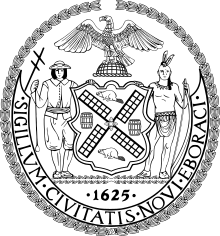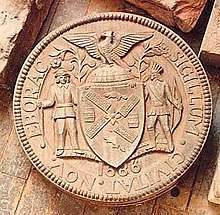Seal of New York City

The seal of New York City, designed in 1915 and adapted from an earlier form dating back in 1686, bears the legend Sigillum Civitatis Novi Eboraci which means simply "The Seal of the City of New York": Eboracum was the Roman name for York in Latin, the titular seat of James II as Duke of York. York was founded by the Romans in 70 AD.
Overview

The two supporters represent the unity between Native Americans and colonists: dexter, a sailor colonist holds a plummet—a navigational tool—in his right hand, while over his right shoulder is a cross-staff; sinister, a Lenape native to Manhattan rests his left hand upon a bow.
Upon the arms / shield, the four windmill sails recall the city's Dutch history as New Amsterdam and the beavers and flour barrels signify the city's earliest trade goods (see History of New York City). The flour barrels and windmills represent the tremendous wealth generated by New York City from the Bolting Act of 1674.[2] The act gave the city an exclusive monopoly to mill and export flour. The shield and supporters rest upon a horizontal laurel branch.
The crest over the seal is the bald eagle, added in 1784, after the American Revolution. Prior to this change, a crown had been located in this space, representing the authority of the monarchy during the British colonial period. The eagle rests upon a hemisphere. At the bottom is the date, 1625, when Fort Amsterdam was designated the capital of the province of New Amsterdam, the colonial Dutch settlement which would later become the City of New York. The first Dutch settlers actually arrived in the region in 1624, and the town of New Amsterdam was incorporated in 1653.[3] The English came in 1664, and the Dutch Governor Peter Stuyvesant surrendered, signing the English documents on September 8, 1664, whereupon it was renamed New York. The 300th Anniversary of New York was celebrated with the World's Fair in New York in 1964 in Flushing Meadows, within the borough of Queens, where religious freedom was first recognized with the Flushing Remonstrance in 1657. A laurel wreath encircles the seal.
The city clerk is the custodian of the City Seal.
Changes to the seal
.png)
| Year of change | Description of change(s) made |
|---|---|
| 1784 | Bald eagle was added to replace a crown.[3] |
| 1915 | Complete overhaul of the seal by a blue-ribbon committee appointed by the City Art Commission.[4] |
| 1977 | Changed the date from 1664 to 1625.[3] |
Prior to 1915, New York City's contemporary seal lacked an official standard, and was often subject to variations featuring a number of different arrangements of the eagle, and the two figures at either side of the coat of arms. For this reason the New York Arts Commission formed a blue-ribbon committee to create a new seal and flag.[4] This committee worked with the New-York Historical Society to study imagery and seals going back to the earliest days of New Amsterdam.[5] Incorporating that historical iconography, the committee developed a new seal and flag design, which was submitted to the board of aldermen on March 16, 1915. The board approved the recommendations seven days later, and the Arts Commission contracted renowned American sculptor Paul Manship to develop a physical version of the revised seal which could be duplicated across city departments as an official symbol.


With the exception of changing the year from 1664 to 1625, the official seal has remained in use ever since.[6][7]
An alternate version of the seal, without the Latin legend, is found on the city flag.[8]
References
- ↑ Description:
- Arms: Upon a shield, saltire-wise, the sails of a windmill. Between the sails, in chief a beaver, in base a beaver, and on each flank a flour barrel.
- Supporters: Dexter, a sailor, his right arm bent, and holding in his right hand a plummet; his left arm bent, his left-hand resting on the top of the shield; above his right shoulder, a cross-staff. Sinister, an Indian of Manhattan, his right arm bent, his right hand resting on top of the shield, his left hand holding the upper end of a bow, the lower end of which rests on the ground. Shield and supporters rest upon a horizontal laurel branch.
- Date: Beneath the horizontal laurel branch the date 1625, being the year of the establishment of New Amsterdam.
- Crest: An American eagle with wings displayed, upon a hemisphere.
- Legend: Upon a ribbon encircling the lower half of the design the words "Sigillum Civitatis Novi Eboraci," meaning Seal of the City of New York.
- ↑ "New York's 250th Anniversary". The New York Times Magazine. June 20, 1915. p. SM12. Retrieved 2010-08-23.
- 1 2 3 Roberts, Sam (July 14, 2008). "New York's Birth Date: Don't Go by City's Seal". The New York Times. Archived from the original on 2015-04-19. Retrieved 2010-08-23.
- 1 2 Pine, John B. (1915). Seal and Flag of the City of New York : Authorized by the Committee Appointed by the Mayor to Commemorate the Two Hundred and Fiftieth Anniversary of the Installation of the First Mayor and Board of Aldermen of the City of New York on June 24, 1665, and the Adoption of the Official City Flag on June 24, 1915. New York: G. P. Putnam's Sons. Retrieved 21 December 2016.
- ↑ "Of Seals and Rampant Beavers: New York City's Flag on its 100th Birthday". New-York Historical Society. Retrieved 21 December 2016.
- ↑ Bogart, Michele H. (2006). The Politics of Urban Beauty: New York and Its Art Commission. Chicago: The University of Chicago Press. p. 152.
- ↑ Hall, Edward Hagaman (1915). "Appendix H – Seal and Flag of the City of New York". Twentieth Annual Report of the American Scenic and Historic Preservation Society to the Legislature of the State of New York. Albany: J. B. Lyon Company, Printers. p. 819.
- ↑ "New York City Administrative Code". amlegal.com. American Legal Publishing Corporation. Retrieved 21 December 2016.